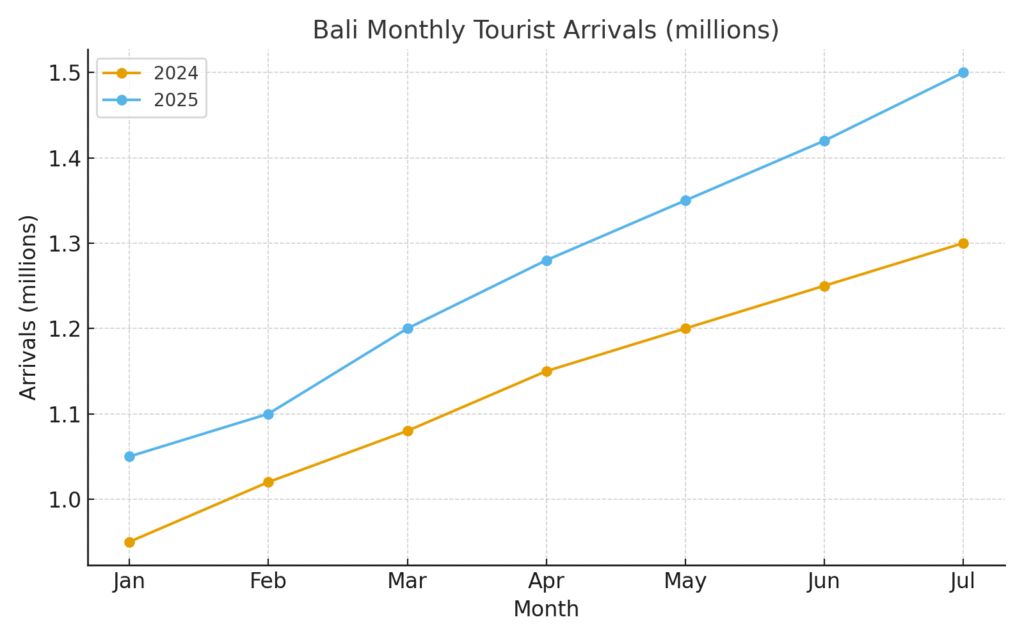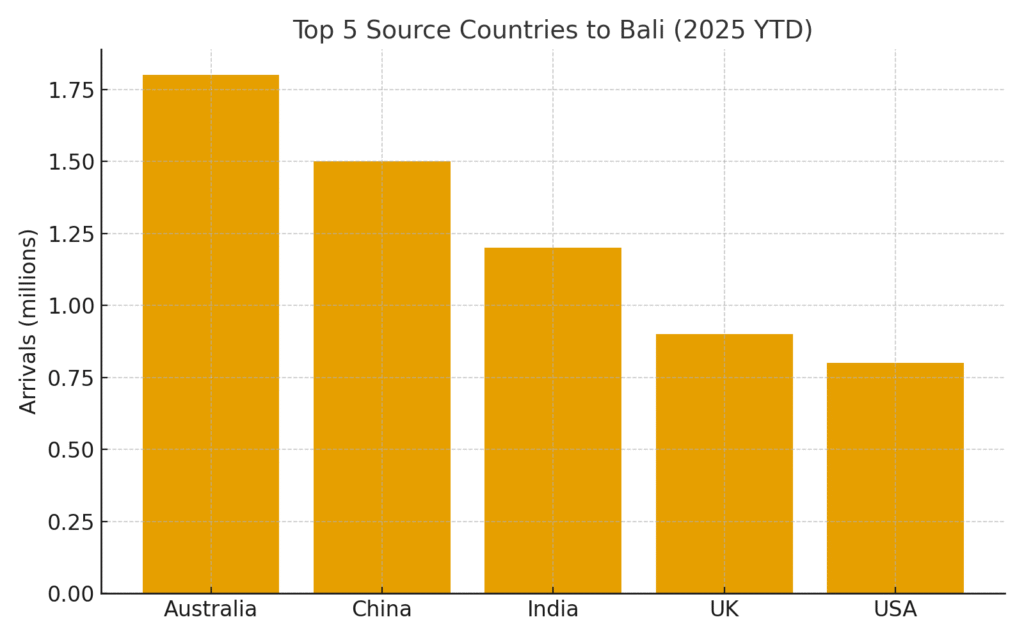Bali Tourism Skyrockets in 2025: Record Growth, Digital Travel, and the Future of Paradise
Bali tourism in 2025 is smashing records with more than 7 million international arrivals, positioning the island as a year-round global hotspot. July alone saw nearly 700,000 foreign visitors, while Ngurah Rai International Airport managed over 2.3 million passengers in August. Strong feeder markets from Australia, India, China, France, and South Korea drive growth, complemented by resilient domestic tourism. New digital upgrades like the All Indonesia App are streamlining arrivals, while niche travel , wellness retreats, eco-tourism, and digital nomad hubs ,is broadening Bali’s appeal. Yet, with success comes new challenges: infrastructure strain, environmental stress, and cultural preservation. The question now is whether Bali can balance booming growth with sustainability and opportunity for both locals and global investors.
Bali Breaks Records in 2025
Bali has always held a special place on the global tourism map, but 2025 is proving to be a watershed year. With more than 7 million international visitors expected, the island is not just meeting but surpassing every target set by tourism authorities. Ngurah Rai International Airport has handled an average of 75,000 travelers daily, showing that even during what was once called the “low season,” Bali is thriving.
But the story goes beyond numbers. It’s about how Bali is reinventing itself as a destination for every type of traveler — from surfers to yogis, backpackers to digital nomads, honeymooners to business investors. At the same time, the island is grappling with pressing questions of sustainability, infrastructure, and cultural preservation.
This article explores Bali’s record-breaking tourism boom in 2025, the forces driving it, the challenges it faces, and the opportunities ahead for investors, businesses, and the local community.
Bali by the Numbers: A Record Year

The statistics paint a clear picture of growth:
- July 2025: 697,110 foreign tourists, an 11.42% increase year-on-year.
- January–July 2025 cumulative arrivals: 3.98 million, up 12.46% on 2024.
- August 2025 airport traffic: 2.33 million passenger movements, with 63% international.
- Daily average: More than 3,100 people processed every hour at Ngurah Rai.
Compared to the pandemic slump of 2021, these numbers are staggering. The recovery has not just been fast ,it has been transformative, redefining what Bali’s tourism calendar looks like.
What’s Driving the Tourism Boom?
1. Strong Source Markets

Australia remains Bali’s most reliable market, with Indians and Chinese tourists returning in big numbers. European travelers, especially the French, are rediscovering Bali, while South Korea has emerged as a steady growth market.
Each group brings unique motivations:
- Australians: surfing, beaches, family vacations.
- Indians: luxury holidays, weddings, and group travel.
- Chinese: shopping, iconic spots, and group tours.
- French & Koreans: wellness, cultural immersion, and nature.
This diversity keeps Bali resilient throughout the year.
2. Domestic Tourism as a Cushion
When international flows dip, Indonesian travelers keep Bali alive. Java, Sumatra, and Sulawesi residents see Bali as both a convenient getaway and a cultural hub, ensuring hotels and restaurants remain busy.
3. Digital Travel Upgrades
The All Indonesia App, launched in September 2025, has streamlined arrivals by combining health checks, customs, and border processes into one digital platform. Combined with e-visa systems, this has positioned Bali as one of Asia’s smoothest entry points.
4. Infrastructure Improvements
Ngurah Rai International Airport has added staff, expanded customs lanes, and upgraded digital passenger flow systems. But with over 75,000 travelers daily, demand continues to outpace supply, raising questions about long-term infrastructure planning.
Regional Ripples: How Tourism Shapes Bali’s Towns
- Kuta, Legian & Seminyak: High occupancy hotels, vibrant nightlife, but growing crowding concerns.
- Canggu: The new “it” spot for digital nomads and influencers, with boutique villas, co-working hubs, and wellness retreats. Congestion is its biggest challenge.
- Ubud: Thriving in wellness and culture, from yoga retreats to cooking classes and temple tours.
- Sanur: Rebranding as a calm, family-friendly hub, attracting retirees and expats alongside tourists.
- East Bali (Amed, Candidasa): Diving and off-grid escapes gaining momentum.
- North Bali (Lovina, Singaraja): Dolphin tours and cultural tourism are rising, though access remains limited by infrastructure gaps.
Niche Travel Trends Driving Growth
- Wellness tourism: yoga, detox retreats, and holistic healing in Ubud and beyond.
- Eco-tourism: coral reef protection, jungle treks, and eco-lodges.
- Adventure tourism: surfing in Canggu, diving in Amed, hiking Mount Batur.
- Cultural immersion: Balinese cooking schools, temple ceremonies, village tourism.
- Digital nomadism: co-living, co-working, and long-stay visas driving year-round visits.
These niches are not just trends but also higher-value segments that contribute more per visitor while spreading tourism across regions.
The Double-Edged Sword: Sustainability Challenges
Bali’s growth story raises tough questions:
- Environmental stress: Waste management, water shortages, and pollution threaten ecosystems.
- Cultural impact: Rapid tourism can erode traditions if development outpaces preservation.
- Over-tourism: Canggu traffic jams and Seminyak crowding risk alienating visitors.
To respond, Bali has introduced the Tourism Levy, funneling funds into waste management, infrastructure, and heritage protection. Local businesses are also embracing eco-friendly practices, from banning plastics to investing in solar energy.
Opportunities for Investors and Local Businesses
While tourists see beaches and temples, investors see opportunity. Bali’s 2025 boom highlights areas ripe for growth:
- Boutique hospitality: eco-resorts, wellness retreats, and boutique villas.
- Technology in travel: booking platforms, AI-driven guest services, and smart infrastructure.
- Property investment: both short-term rentals and long-stay villas for digital nomads.
- Sustainability ventures: eco-lodges, waste recycling, and green infrastructure.
- Cultural tourism projects: authentic experiences that add value while protecting traditions.
The Road Ahead: Bali at a Crossroads
Bali has a choice. It can ride the wave of booming tourism without restraint, risking environmental and cultural degradation. Or it can strike a balance, making growth sustainable while creating shared benefits for locals, businesses, and visitors.
The good news is that Bali has a track record of resilience. From the Asian financial crisis to the pandemic, the island has always bounced back stronger. If it can continue blending tradition with innovation, 2025 may not just be the year of record arrivals — it could mark the start of a new era where Bali becomes the global benchmark for sustainable tourism.
Bullet Point Summary (Key Takeaways)
- Over 7 million international arrivals forecast in 2025.
- Ngurah Rai Airport handles 75,000+ daily travelers.
- Top source markets: Australia, India, China, France, South Korea.
- Domestic tourism remains a strong stabilizer.
- All Indonesia App streamlines entry processes.
- Regional hotspots diversifying: Canggu, Ubud, Sanur, East Bali, North Bali.
- Niche markets: wellness, eco-tourism, cultural travel, digital nomads.
- Sustainability concerns: waste, water, traffic, culture.
- Bali Tourism Levy supports eco-initiatives.
- Investor opportunities in eco-resorts, villas, property, and tech solutions.





